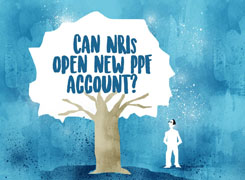Hello Sir, I had opened a PPF account in the year 2004, wherein I deposited at least Rs 10,000 per annum in each year till the year 2018. Subsequent to 2018, I did not deposit any further amount in my PPF account. Currently, my PPF account is treated as dormant, however every year interest is credited to my PPF account. I have not withdrawn from my PPF account so far. I have been advised to withdraw my PPF balance and close my account. My questions are as follows:
1) Is the interest income of PPF interest accrued so far, taxable and whether to be disclosed in the income tax returns?
2) Can I change the status of my PPF account from dormant to active? What are the documents required for it and the procedures involved?
3) If I choose to close my PPF account, will the PPF proceeds be subject to deduction of tax?
4) If I choose to continue with my PPF account without making any contributions, will it earn interest till the date of closure of PPF account?
Thanks in advance.
Ans: Thank you for your detailed inquiry. Let’s address each of your concerns step-by-step to help you make an informed decision regarding your PPF account.
1. Tax Implications of PPF Interest Income
Tax Exemption Status
Public Provident Fund (PPF) is one of the most tax-efficient investment options in India. The interest accrued on PPF is completely tax-free under Section 10(11) of the Income Tax Act, 1961.
Reporting in Income Tax Returns
Since the interest earned on PPF is tax-free, you are not required to disclose this interest income in your income tax returns. This holds true as long as the PPF account remains active or dormant, and interest continues to be credited.
2. Reactivating Your Dormant PPF Account
Procedure to Reactivate
To change the status of your PPF account from dormant to active, follow these steps:
Submit a Written Request: Visit your bank or post office where the PPF account is held and submit a written request to reactivate the account.
Pay the Minimum Contribution: You will need to pay the minimum annual contribution of Rs 500 for each year the account was dormant. Since your account has been dormant since 2018, calculate the total contribution required (Rs 500 per year x number of dormant years).
Penalty Payment: A penalty of Rs 50 per inactive year is also required.
Submit Required Documents: Provide necessary documents such as your PPF passbook and identity proof.
Documents Required
PPF Passbook
Identity Proof (Aadhar, PAN, etc.)
Written application for reactivation
Once these steps are completed, your account will be reactivated and you can continue making contributions.
3. Closing Your PPF Account
Procedure to Close the Account
If you choose to close your PPF account, visit the bank or post office where your account is held and submit a closure application. You will need to fill out Form C (Application for Withdrawal) and submit it along with your PPF passbook and identity proof.
Tax Implications on Closure
The proceeds from your PPF account, including the principal and interest earned, are completely tax-free. There is no tax deduction on the amount received upon closure.
4. Continuing the Dormant PPF Account
Interest Accrual on Dormant Account
Even if you do not make any further contributions, your PPF account will continue to earn interest until it matures. The interest rate is set by the government and is subject to periodic changes. This interest will continue to be credited to your account annually until the maturity date.
Evaluating Your Options
Reactivating vs. Continuing Dormant
Reactivating: This option allows you to continue benefiting from the tax-free returns of PPF by making the minimum contributions and paying the penalty. It keeps the account active and provides flexibility for future contributions.
Continuing Dormant: If you prefer not to make further contributions but want to keep earning interest, allowing the account to remain dormant is a viable option. The account will continue to grow with interest until maturity.
Closing the Account
If you need immediate access to funds or prefer to invest elsewhere, closing the account is straightforward and tax-efficient. The full amount received will be tax-free.
Strategic Recommendations
Diversify Investments
While PPF is a secure and tax-efficient investment, consider diversifying your portfolio for better returns. Options include:
Mutual Funds: Actively managed mutual funds can offer higher returns compared to PPF.
Equity Investments: For higher risk tolerance, equity investments provide potential for significant growth.
Maintain a Balanced Portfolio
A balanced portfolio includes a mix of fixed-income securities like PPF and higher-growth investments like mutual funds and equities. This strategy optimizes returns while managing risk.
Final Thoughts
Your decision should align with your financial goals and liquidity needs. Reactivating the account provides flexibility, while continuing with a dormant account or closing it can meet immediate financial needs.
Conclusion
Your PPF account offers flexibility and tax-free returns, making it a valuable part of your portfolio. Whether you choose to reactivate, continue as dormant, or close the account, each option has its benefits.
Tax-free Interest: PPF interest remains tax-free.
Reactivation: Pay contributions and penalties to reactivate.
Closure: Tax-free proceeds upon closing the account.
Dormant: Interest continues until maturity.
Make an informed decision based on your financial goals and requirements.
Best Regards,
K. Ramalingam, MBA, CFP,
Chief Financial Planner,
www.holisticinvestment.in





























